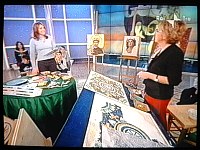
Deutsch Español Français Italiano Português Руccкий 日本語

Introduction With such tiny tesserae, 1 or 2 mm it was therefore possible to copy paintings using stones and using a different medium. Reducing the tesserae to such dimensions you would obtain 5 rows of tesserae in one centimeter of mosaic thus more variations in colour.
These precious mosaics were made in a laboratory on an autonomous support system and installed into a floor. These small carpets were called “Emblema” or “Emblemata” and were like precious paintings inserted into a floor with public visibility giving the room a great importance.
Goal of the course Requirements All classes are taught in English (we speak a little Spanish and French too) |
||||||||
| PROGRAMME OF THE MICRO-MOSAIC COURSE MONDAY Morning Students will have an introduction on the technique of “Opus Vermiculatum”, a lesson on cutting and they will choose the subject to reproduce. Since these mosaics require longer working times we provide subjects which are approx 4"x4" (10x10cm) Afternoon Cutting and tracing the subject. TUESDAY Morning & Afternoon Working the whole day on the mosaic. WEDNESDAY Morning Continuing work on the mosaic. Afternoon Lesson with a demonstration of “Filato” mosaic in smalti glass. Students will see how “Filato” mosaics are made from the fusion and filamenting of the smalti to placing the tesserae. THURSDAY Morning Continue working on the mosaic. Afternoon A slide lesson on the history and evolution of “Emblema” mosaics. FRIDAY Morning Finishing the mosaic. Afternoon We take the students on a mosaic guided tour. |
||||||||
 Luciana on TV program Luciana on TV program"Geo&Geo" RAI 3 |
Luciana Notturni founded the Mosaic Art School in Ravenna, where she teaches the most important techniques of mosaic making and restoration. |
|||||||
|
Questions & comments, email to: info@ mosaicschool.com |
||||||||